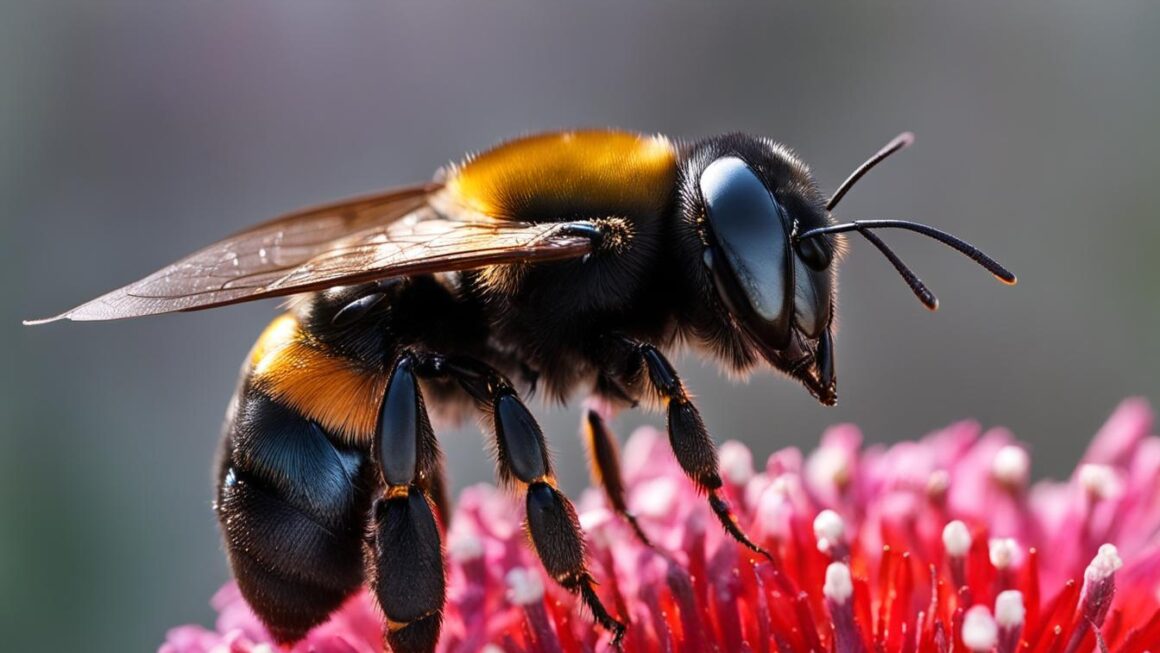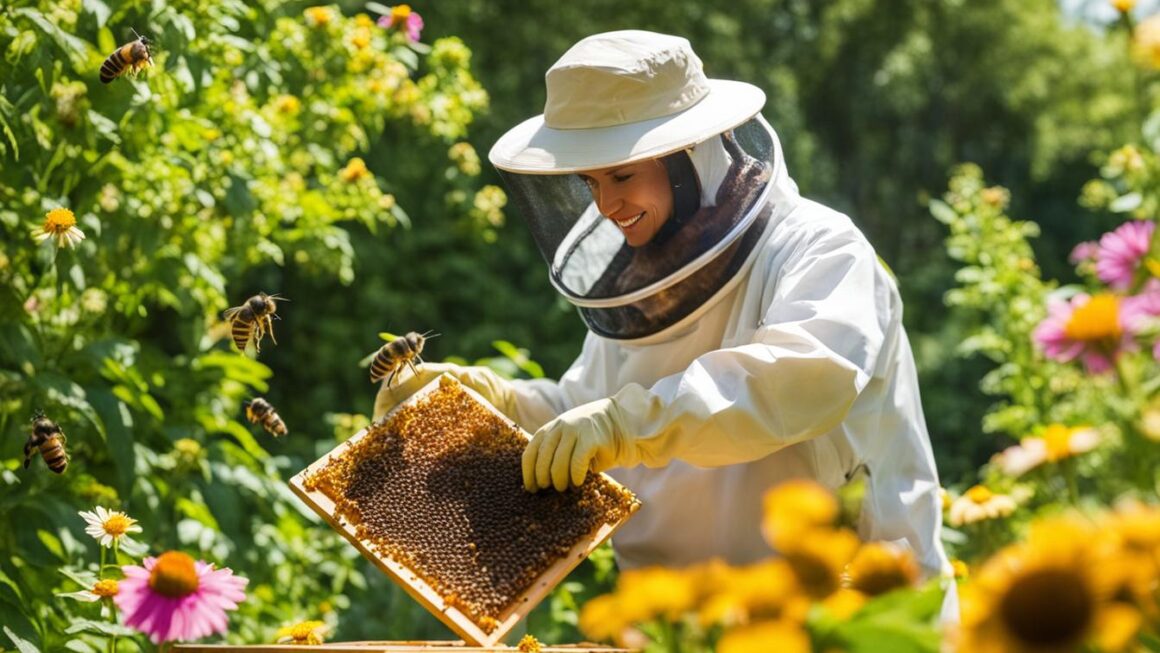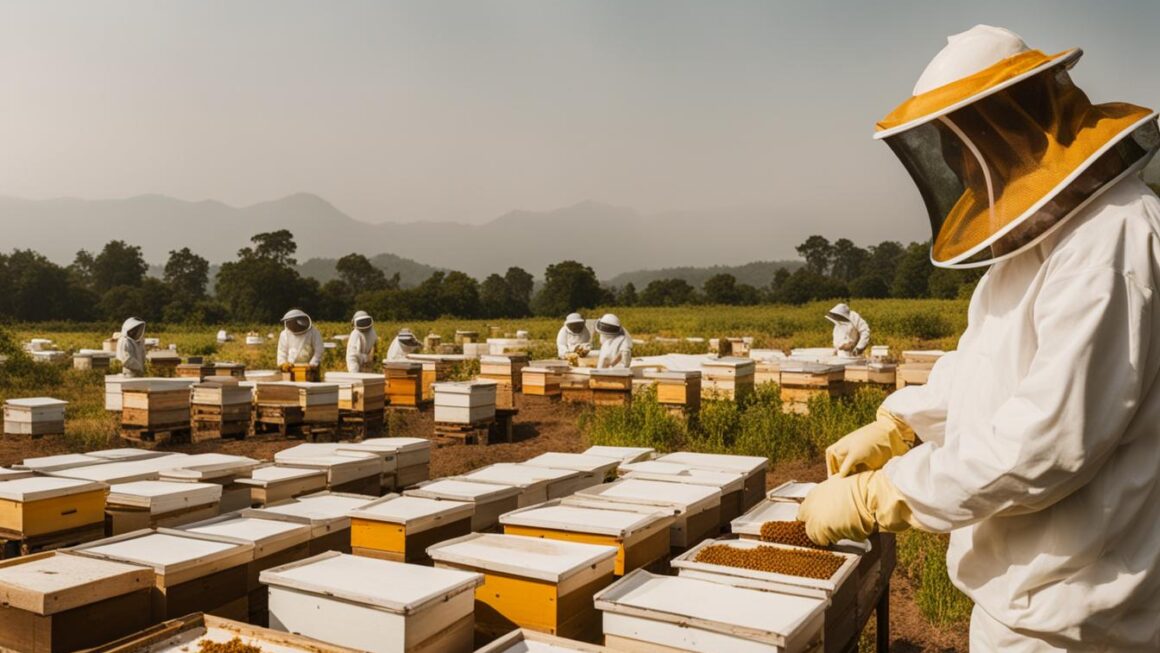A carpenter bee infestation can be a frustrating and damaging problem for homeowners. These bees can cause significant damage to wood structures, compromising their integrity and leading to costly repairs. Fortunately, there are effective spray solutions available that can help eliminate carpenter bees and protect your property.
Key Takeaways:
- Using the right spray is crucial for effectively eliminating carpenter bees.
- Choose sprays specifically designed for carpenter bees for best results.
- Active ingredients in these sprays are lethal to carpenter bees.
- Proper treatment can prevent further infestation and damage.
- Identify the signs of a carpenter bee infestation before using sprays.
Identifying Carpenter Bees: How to Tell if You Have an Infestation
Properly identifying a carpenter bee infestation is crucial for effective treatment and control. These bees can often be mistaken for bumblebees due to their similar size and appearance. However, there are key traits that differentiate them. Carpenter bees have a hairless and shiny abdomen, while bumblebees have a more yellow abdomen covered in hair. This distinctive feature can help you distinguish between the two.
Another characteristic of carpenter bees is their nesting behavior. Unlike bumblebees that typically nest in the ground, carpenter bees burrow into wood to create tunnels and galleries. These tunnels are often noticeable as round holes in wood structures. Additionally, carpenter bees leave behind yellow fecal stains on wood and sawdust, also known as frass, around the holes.
If you observe any of these signs, it is likely that you have a carpenter bee infestation. However, if you are uncertain or want confirmation, it is advisable to consult a pest control professional who can accurately identify the presence of carpenter bees and provide the appropriate treatment.
Table: Identifying Signs of Carpenter Bee Infestation
| Signs of Infestation | Description |
|---|---|
| Holes in Wood | Round entrance holes in wooden surfaces |
| Yellow Fecal Stains | Visible yellow stains on wood |
| Sawdust (Frass) | Piles of fine sawdust near the holes |
By closely observing and recognizing these signs, you can quickly determine if your property is affected by carpenter bees. Identifying the infestation early allows for timely intervention and treatment, preventing further damage to your wood structures.
Inspecting Your Property for Carpenter Bee Activity
Once you’ve identified that you have a carpenter bee infestation, it’s important to conduct a thorough inspection of your property to determine the extent of the problem and to locate active carpenter bee activity. By inspecting your property, you can identify the areas that require treatment and focus your efforts on eliminating the infestation.
When conducting an inspection, pay close attention to areas where carpenter bees are commonly active. These include eaves, railings, posts, and wooden furniture. Look for signs of carpenter bee activity, such as holes in the wood and sawdust (frass) around the holes. These are clear indications of their presence.
Tip: Use a flashlight to inspect hard-to-reach areas, as carpenter bees often prefer to nest in dark and secluded spots.
During the inspection, it’s important to be thorough and check all potential locations where carpenter bees may be nesting. Remember that carpenter bees can create multiple tunnels and galleries within wood, so make sure to examine all wooden structures on your property. By being meticulous in your inspection, you can ensure that no areas go unnoticed, enabling you to effectively address the carpenter bee infestation.
| Areas to inspect for carpenter bees: | Signs of carpenter bee activity: |
|---|---|
| Eaves and overhangs | Holes in wood |
| Railings and fences | Sawdust (frass) around the holes |
| Wooden posts and beams | Yellow fecal stains on wood |
| Wooden furniture | Increased bee activity around certain areas |
Effective Treatment Options for Carpenter Bees
Carpenter bees can be a nuisance and pose a threat to wooden structures. It’s important to implement effective treatment options to eliminate these pests and protect your property. Here are some recommended methods for getting rid of carpenter bees:
1. Fipro Foaming Aerosol
Fipro Foaming Aerosol is a popular and effective spray specifically formulated to target carpenter bees. It contains the active ingredient fipronil, which is lethal to the bees. To use this product, simply spray it directly into the carpenter bee holes and galleries. The foam expands into the tunnels, ensuring maximum coverage and contact with the bees. This contact will effectively kill the bees and eliminate the infestation. After treating the holes, it’s important to seal them with wood putty to prevent reinfestation.
2. Dominion 2L Insecticide Concentrate
In addition to using a foaming aerosol, applying an insecticide concentrate like Dominion 2L can help prevent future infestations. Dominion 2L is a non-repellent insecticide that creates a barrier, deterring carpenter bees from targeting your property. To use this product, mix it with water according to the instructions and apply it as a surface spray to areas prone to infestation, such as eaves, railings, and wooden furniture. The insecticide will provide long-lasting protection and help keep carpenter bees away.
3. Wood Putty and Sealing
When treating carpenter bee holes, it’s important to seal them properly to prevent reinfestation. After using the foaming aerosol, fill the holes with wood putty and smooth out the surface. This will close off the entry points and make it difficult for carpenter bees to burrow back in. It’s also a good idea to seal any exposed wood with paint or sealant, as this can make it less appealing for carpenter bees to drill into.
By using the right treatment options and taking preventative measures, you can effectively control carpenter bee infestations and protect your property from further damage.
Natural Remedies for Carpenter Bee Control
If you prefer to avoid using chemical sprays, there are natural remedies that can help control carpenter bees. These DIY solutions can be effective in repelling and deterring carpenter bees from your property. Here are a few natural remedies you can try:
Citrus Spray
Carpenter bees are sensitive to the smell of citrus fruits. You can create a natural spray by mixing citrus essential oil with water in a spray bottle. Spray the solution on the affected areas, such as wooden structures and furniture, to repel carpenter bees. Reapply the spray regularly to maintain its effectiveness.
Garlic Mixture
Another effective natural remedy is a garlic mixture. Crush several cloves of garlic and mix them with oil and vinegar to create a strong-smelling solution. Spray this mixture on the areas where carpenter bees are active. The strong odor will help keep them away from your property.
Borate and Wood Preservatives
Using borate and wood preservatives, such as Tim-Bor Professional Insecticide, can make the wood unappealing for carpenter bees to nest in. These treatments can be applied to wooden structures to protect them from infestations. Follow the instructions on the product label for proper application.
It’s important to note that while these natural remedies can be effective, they may not provide the same level of control as chemical sprays. For severe infestations or persistent carpenter bee problems, it’s recommended to consult with a professional pest control service for expert advice and assistance.
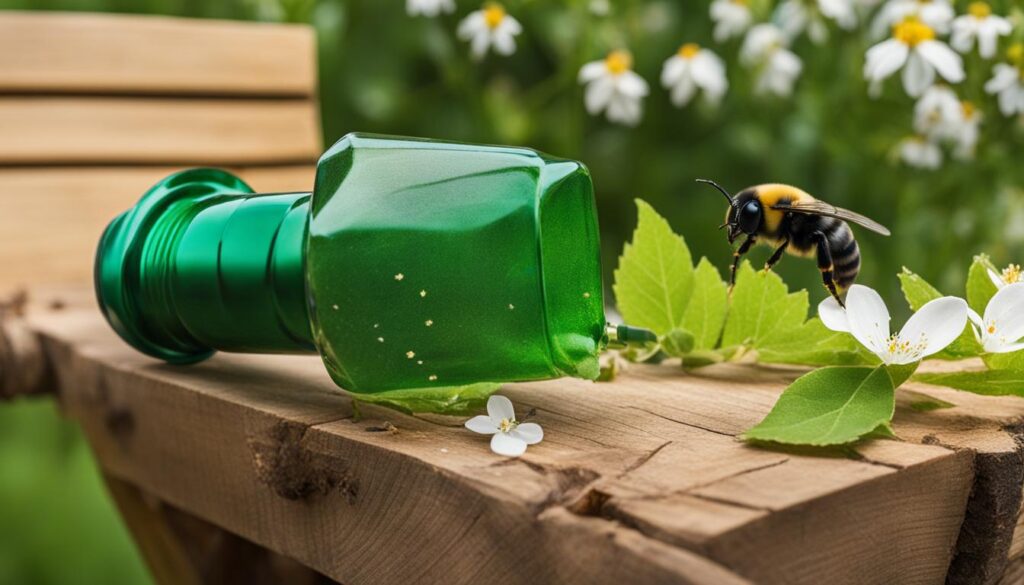
Preventing Carpenter Bee Reinfestation
Once you have successfully treated a carpenter bee infestation, it is crucial to take preventative measures to avoid reinfestation. By implementing the following strategies, you can help protect your property from future carpenter bee infestations and maintain the integrity of your wooden structures:
1. Apply a Preventative Treatment:
One effective method is to apply a preventative treatment using an insecticide concentrate like Dominion 2L. This will create a barrier that deters carpenter bees from targeting your property. It is recommended to apply this treatment during the peak carpenter bee season, which is in the early spring to early summer.
2. Seal Exposed Wood:
Sealing any exposed wood with paint or sealant can make it less attractive for carpenter bees to drill into. By creating a protective layer, you can reduce the likelihood of carpenter bees choosing your property as a nesting site.
3. Regular Inspections:
Continuously inspecting your property for signs of carpenter bee activity is essential for early detection and prompt action. By identifying any potential new infestations early on, you can address them promptly and prevent them from spreading.
“By implementing preventative measures and staying proactive, you can significantly reduce the risk of carpenter bee reinfestations and ensure the long-term protection of your property.”
4. Maintain Wood Structures:
Regular maintenance of wood structures is crucial in preventing carpenter bee infestations. Keep an eye out for any signs of wood decay or damage, as this can make them more susceptible to carpenter bee activity. Repair or replace damaged wood promptly to maintain the integrity of your structures.
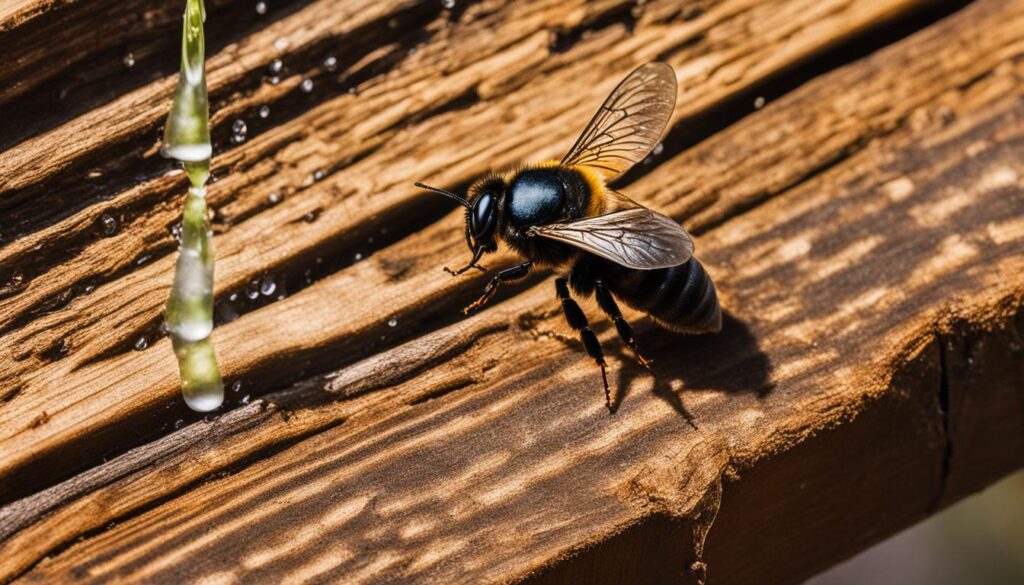
5. Seek Professional Advice:
If you continue to experience issues with carpenter bees despite your best efforts, it may be beneficial to seek professional advice from a pest control specialist. They can provide expert insight, recommend targeted treatments, and offer long-term solutions to prevent carpenter bee reinfestations.
By implementing preventative measures and staying proactive, you can significantly reduce the risk of carpenter bee reinfestations and ensure the long-term protection of your property. Remember to regularly inspect your property, apply preventative treatments, maintain wood structures, and seek professional advice when needed. With these strategies in place, you can successfully prevent carpenter bee infestations and preserve the beauty and integrity of your wooden structures.
The Importance of Proper Identification and Treatment
Proper identification and treatment are essential when dealing with a carpenter bee infestation. Identifying the presence of carpenter bees accurately is crucial for effective control. Mistaking these bees for other similar-looking species can lead to ineffective treatment methods and wasted time and resources. By observing key traits and behavior, such as the hairless and shiny abdomen compared to bumblebees’ hairy abdomen, you can correctly identify carpenter bees.
Once you have identified carpenter bees, it is important to choose the right treatment options. Using sprays specifically designed for carpenter bees, such as Fipro Foaming Aerosol, can effectively eliminate these pests. The active ingredient fipronil in this spray targets and kills carpenter bees, ensuring efficient control of the infestation. Additionally, sealing the holes with wood putty after treatment can prevent reinfestation.
Proper treatment is not only important for eliminating carpenter bees but also for preventing reinfestation. Utilizing insecticide concentrates like Dominion 2L can create a non-repellent barrier that deters carpenter bees from returning. Applying this treatment during the peak carpenter bee season, from early spring to early summer, can provide long-lasting protection.
Identifying and Treating Carpenter Bees: Key Points
- Proper identification is crucial for effective treatment
- Distinctive traits differentiate carpenter bees from other similar-looking species
- Use sprays like Fipro Foaming Aerosol to target carpenter bees directly
- Seal treated holes to prevent reinfestation
- Insecticide concentrates like Dominion 2L create a barrier that deters carpenter bees
- Apply treatment during the peak carpenter bee season for long-lasting protection
By understanding the importance of proper identification and treatment, you can effectively control carpenter bee infestations and protect your property. Taking the time to correctly identify these pests and choosing the right treatment options, such as Fipro Foaming Aerosol and Dominion 2L, will ensure efficient elimination of carpenter bees and prevent reinfestation. Proper treatment is key to safeguarding your wooden structures and maintaining a pest-free environment.
The Risks of Untreated Carpenter Bee Infestations
If left untreated, carpenter bee infestations can pose significant risks and cause extensive damage to wooden structures. These pests can create tunnels and galleries in wood, compromising its structural integrity over time. This damage can be particularly concerning for doors, windows, fences, and furniture made of wood, as weakened structures may eventually collapse or require costly repairs.
Moreover, untreated carpenter bee infestations can attract other pests, such as woodpeckers and rodents, who may further damage your property. Woodpeckers are known to peck at the holes created by carpenter bees, exacerbating the structural damage. Additionally, rodents may take advantage of weakened wood to create their own nests or access your home, leading to potential interior damage and health risks.
To prevent these risks, it is essential to address carpenter bee infestations promptly and effectively. By implementing proper treatment methods, such as using targeted sprays like Fipro Foaming Aerosol, you can eliminate these pests and protect your property from further damage.
| Untreated Carpenter Bee Infestations Risks | Damage Caused by Carpenter Bees |
|---|---|
| Weakened structural integrity of wooden elements, including doors, windows, fences, and furniture | Creation of tunnels and galleries in wood, compromising its strength |
| Increased risk of collapse or costly repairs | Attracting woodpeckers who peck at the holes, worsening the damage |
| Potential access points for rodents, leading to interior damage and health risks | Attracting rodents who create nests in weakened wood |
By understanding the risks associated with untreated carpenter bee infestations, you can take the necessary steps to protect your property and ensure its long-term integrity.
Professional Bee Removal Services for Carpenter Bees
If you find yourself dealing with a stubborn carpenter bee infestation that DIY treatments haven’t been able to fully resolve, it might be time to consider enlisting the help of professional bee removal services. These experts have the knowledge, experience, and specialized equipment to safely and effectively remove carpenter bees from your property, ensuring the safety of your family and the integrity of your home.
Professional bee removal services, such as Bee Serious Bee Removal, offer efficient and thorough solutions for carpenter bee infestations. They will conduct a comprehensive inspection of your property to identify all active bee nests and determine the extent of the infestation. Once the nests are located, the professionals will use effective and safe techniques to remove the carpenter bees without causing harm to the bees or your property.
By hiring expert bee removal services, you can have peace of mind knowing that the infestation will be properly addressed. These professionals have access to powerful insecticides that are not available to the general public, allowing them to effectively eliminate the carpenter bees. They can also provide recommendations on preventive measures to help you avoid future infestations.
When it comes to carpenter bee control, professional removal services offer the expertise and resources needed to ensure successful pest control. Whether you have a small infestation or a widespread problem, their knowledge and experience make them the best choice for effectively and safely removing carpenter bees from your property.
Conclusion
Carpenter bee infestations can be a nuisance and cause damage to wooden structures. However, with the right treatment approach and preventative measures, you can effectively control and prevent carpenter bee infestations.
Using sprays specifically designed for carpenter bees, such as Fipro Foaming Aerosol, and applying insecticide concentrates like Dominion 2L can help eliminate these pests and protect your property.
Additionally, natural remedies, such as citrus sprays and garlic mixtures, can provide alternative methods of control. It’s important to properly identify carpenter bees and seek professional bee removal services if needed to ensure effective and safe pest control.
FAQ
What is the best spray to use for carpenter bees?
Fipro Foaming Aerosol is a recommended spray specifically formulated to target carpenter bees.
How can I identify if I have a carpenter bee infestation?
Look for holes in wood structures, yellow fecal stains on wood, and sawdust (frass) around the holes as signs of a carpenter bee infestation.
Where should I inspect for carpenter bee activity?
Pay close attention to areas such as eaves, railings, posts, and wooden furniture where carpenter bees are commonly active.
What treatment options are effective for carpenter bees?
Fipro Foaming Aerosol can be sprayed directly into the carpenter bee holes and galleries. Dominion 2L insecticide concentrate can be used to create a non-repellent barrier to deter carpenter bees.
Are there natural remedies for carpenter bee control?
Yes, spraying citrus scent on affected areas or using a mixture of garlic, oil, and vinegar can help repel carpenter bees. Using borate and wood preservatives can also make wood unappealing for carpenter bees to nest in.
How can I prevent carpenter bee reinfestation?
Applying a preventative treatment using Dominion 2L insecticide concentrate and sealing exposed wood with paint or sealant can deter carpenter bees from targeting your property.
Why is proper identification and treatment important for carpenter bees?
Mistaking carpenter bees for other bees can lead to ineffective treatment methods. Proper identification and treatment ensure successful elimination and prevent further damage.
What are the risks of untreated carpenter bee infestations?
Untreated infestations can lead to significant damage to wood structures and potentially attract other pests that can cause further damage.
Should I consider professional bee removal services for carpenter bees?
Professional bee removal services have the expertise and specialized equipment to safely and effectively remove carpenter bees from your property.

